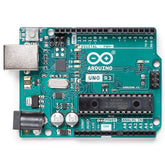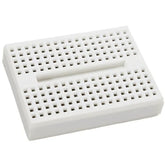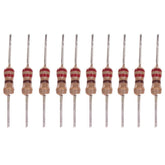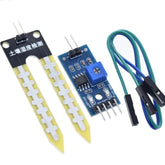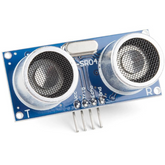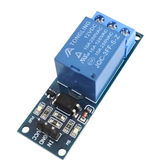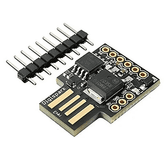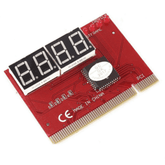Top 10 STEM Projects You Can Build in an Arduino Lab
Summary
The integration of technology and interactive methodologies has revolutionized how educators approach Science, Technology, Engineering, and Math (STEM) concepts.
Modern students thrive when learning becomes engaging, hands-on, and directly applicable to real-world scenarios.
Through carefully designed Arduino Lab Projects, educators can transform traditional lessons into dynamic experiences that foster curiosity, critical thinking, and collaboration among students.
Educational research consistently demonstrates that STEM learning with Arduino creates meaningful connections between abstract concepts and practical applications.
When students engage with interactive challenges, they develop essential problem-solving skills while naturally absorbing complex scientific principles.
This project-based approach to learning not only improves retention but also cultivates the innovative mindset necessary for success in an increasingly technology-driven world.

What is an Arduino Lab?
An Arduino Lab is a dedicated, hands-on environment designed to transform STEM education through project-based learning.
It's a space equipped with Arduino microcontrollers, electronic components, sensors, and software that allows students to build and program digital devices that interact with the physical world.
Arduino is an open-source platform, meaning its hardware designs and software are freely available, making it an affordable and versatile tool for schools and hobbyists alike.
These labs are flexible and scalable, preparing students for future careers by providing practical experience. They empower teachers with user-friendly tools and expert training, enabling them to guide students from basic principles to complex innovations.
Whether for K-12 schools, universities, or vocational training, an Arduino Lab provides the resources for discovery, research, and real-world prototyping.
Top 10 STEM Projects Using Arduino
Here are ten exciting Arduino Lab Project ideas that can be integrated into your curriculum to make learning interactive and impactful.
These projects range from simple circuits to complex robotic systems, offering a progressive learning path for students of all skill levels.
Project 1: The Classic Traffic Light Controller
This is one of the quintessential Arduino beginner projects that serves as a perfect introduction to basic programming logic and hardware control.
Project Description: Students build a miniature traffic light system using red, yellow, and green LEDs. They then write a simple program to control the sequence and timing of the lights, mimicking a real-world traffic signal.
Materials Needed:
- Arduino UNO Board
- 3 LEDs (Red, Yellow, Green)
- 3 Resistors (220-ohm)
- Breadboard
- Jumper Wires
Project Overview: This project introduces students to digital outputs, sequential programming, and the use of delays. They learn how to write code with conditional statements to manage the light sequence, providing a tangible and satisfying result for their first foray into Arduino circuit projects.
Project 2: Automated Plant Watering System
This project is a great entry point into Arduino automation projects and demonstrates how sensors can be used to solve everyday problems.
Project Description: Students create a system that automatically waters a plant when the soil becomes too dry. A soil moisture sensor detects the water level and signals the Arduino to activate a small water pump.
Materials Needed:
- Arduino UNO Board
- Soil Moisture Sensor
- Submersible Water Pump
- Relay Module
- Vinyl Tubing and a Water Container
- Jumper Wires
Project Overview: In this activity, students learn about analog inputs by reading data from the soil moisture sensor. They will program the Arduino to make a decision based on that data—a core concept in automation and robotics. This is one of the most practical Arduino sensor projects for demonstrating the power of feedback loops.
Project 3: Ultrasonic Distance Measurer
This project introduces students to ultrasonic sensors, a key component in many robotics and navigation systems.
Project Description: Students build a digital measuring tape using an ultrasonic sensor that can determine the distance to an object. The distance is then displayed on an LCD screen or the computer's serial monitor.
Materials Needed:
- Arduino UNO Board
- HC-SR04 Ultrasonic Sensor
- 16x2 LCD Display (Optional)
- Breadboard
- Jumper Wires
Project Overview: Students will work with sensor libraries and learn the physics behind how ultrasonic waves are used for measurement. This project involves both sending a signal (trigger) and receiving one (echo), teaching them about digital input/output timing and data conversion.
Project 4: Bluetooth-Controlled Robot Car
This is one of the most engaging Arduino robotics projects, allowing students to build and control their own vehicle wirelessly.
Project Description: Students assemble a small, two-wheeled robot car and program it to be controlled via a smartphone app over a Bluetooth connection.
Materials Needed:
- Arduino UNO Board
- Robot Car Chassis with Motors and Wheels
- L298N Motor Driver
- HC-05 or HC-06 Bluetooth Module
- Battery Pack
- Jumper Wires
Project Overview: This complex project integrates multiple concepts. Students learn about motor control, serial communication via Bluetooth, and power management. They will also get a taste of app development or use a pre-existing app to send commands, bridging the gap between hardware and software interfaces in a fun and interactive way.
Project 5: Home Automation with Relays
This project gives students a safe introduction to controlling higher-voltage devices, a cornerstone of smart home technology and Arduino IoT projects.
Project Description: Students use a relay module to allow their Arduino to switch a standard household lamp or fan on and off based on a command or sensor input (like a clap sensor or a timer).
Materials Needed:
- Arduino UNO Board
- Relay Module (1, 2, or 4 channels)
- A low-voltage lamp or fan to control (for safety)
- Optional: Sound sensor, IR receiver, or RTC module
- Jumper Wires
Project Overview: Safety is paramount here. Students learn how a low-voltage signal from the Arduino can control a high-voltage circuit through a relay, an electromechanical switch. This project demonstrates the practical application of electronics in creating smart, automated environments.
Project 6: IoT Weather Station
This is a fantastic Arduino Lab Project that combines multiple sensors and connects the physical world to the internet.
Project Description: Students build a device that measures temperature, humidity, and barometric pressure using a single sensor. The data is then uploaded to an IoT platform or a web server, allowing it to be monitored from anywhere.
Materials Needed:
- Arduino UNO with a WiFi shield, or an ESP8266/ESP32 board
- BME280 or DHT22 Sensor for temperature, humidity, and pressure
- LCD or OLED Display (Optional)
- Breadboard and Jumper Wires
Project Overview: This project is a deep dive into STEM projects for Arduino lab that focus on the Internet of Things (IoT). Students learn about I2C communication protocols to interface with the sensor, WiFi connectivity, and basic web data handling. They can visualize their data on dashboards, learning about data logging and analysis.
Project 7: Joystick-Controlled Robotic Arm
A step up in complexity, this project is a rewarding challenge that delves into advanced robotics and mechanical control.
Project Description: Students construct a robotic arm with multiple joints using servo motors and control its movement with a two-axis joystick.
Materials Needed:
- Arduino UNO Board
- Robotic Arm Kit (or 3-4 Servo Motors)
- 2-Axis Joystick Module
- External Power Supply for servos
- Breadboard and Jumper Wires
Project Overview: This is an excellent Arduino lab kit project. Students will master controlling multiple servo motors simultaneously, mapping analog inputs from the joystick to precise servo angles. This project provides profound insights into kinematics, mechanical design, and the fine motor control required in industrial robotics.
Project 8: Music-Reactive LED Strip
This fun and visually appealing project is a great way to explore signal processing and create interactive art.
Project Description: Students use a sound sensor to detect the beat and volume of music and program a strip of addressable LEDs (like NeoPixels) to react with dynamic light patterns and colors.
Materials Needed:
- Arduino UNO Board
- Microphone/Sound Sensor Module
- Addressable RGB LED Strip (e.g., WS2812B)
- External Power Supply for the LED strip
- Jumper Wires
Project Overview: This creative Arduino coding project teaches students how to process analog signals from the sound sensor and translate them into stunning visual effects. They'll work with LED libraries and learn about concepts like signal amplitude, frequency, and data visualization.
Project 9: Obstacle-Avoiding Robot
A foundational project in autonomous systems, this robot navigates its environment by detecting and avoiding obstacles.
Project Description: Building on the robot car project, students add an ultrasonic sensor to the front of the robot. They then write a program that allows the robot to roam freely, and upon detecting an obstacle, stop, turn, and find a clear path.
Materials Needed:
- All components from the Bluetooth Robot Car (Project 4)
- HC-SR04 Ultrasonic Sensor
- A servo motor to mount the sensor (for scanning)
Project Overview: This project is at the heart of autonomous navigation. Students will write more complex, decision-based code. The robot must continuously check its surroundings, interpret sensor data, and execute a sequence of movements to navigate. It's a perfect example of a closed-loop control system.
Project 10: Fingerprint Security System
This advanced project introduces students to biometrics and building a high-tech security device.
Project Description: Students build a lockbox or a door access system that only opens when an authorized fingerprint is scanned. The system can provide feedback using LEDs or an LCD screen.
Materials Needed:
- Arduino UNO Board
- Fingerprint Scanner Module (like the R307)
- Servo Motor or Solenoid Lock
- LEDs (Green for access granted, Red for denied)
- LCD Display (Optional)
- Breadboard and Jumper Wires
Project Overview: This is a challenging but highly rewarding Arduino Lab Project. Students learn to interface with a more complex sensor, manage a database of fingerprints (enrolling and deleting users), and control a locking mechanism. It's a fantastic real-world application of embedded systems and security principles.
Skills Students Learn from Arduino STEM Projects
Engaging in Arduino lab activities for schools equips students with a versatile skill set that is highly valuable in the modern world. Beyond the technical knowledge, these DIY Arduino projects cultivate a deeper understanding of STEM principles:
- Programming and Logic: Students learn the fundamentals of coding in C/C++, a language widely used in the professional world. They develop logical thinking by structuring code with loops, conditionals, and functions to solve problems.
- Electronics and Circuitry: Students gain hands-on experience with electronic components like resistors, LEDs, sensors, and motors. They learn to read schematics and build functional Arduino circuit projects on breadboards.
- Problem-Solving: Debugging a circuit that doesn't work or code that has a bug is a powerful learning experience. Students develop resilience and analytical skills as they troubleshoot their Arduino electronics projects step-by-step.
- Data Analysis: Projects involving sensors require students to read, interpret, and act on data. An IoT weather station, for example, teaches them to collect and visualize data, a key skill in any scientific field.
How Arduino Labs Encourage Creativity and Problem-Solving
Arduino's open-source nature is its greatest strength in an educational setting. Unlike proprietary kits with a fixed outcome, Arduino provides a blank canvas. An Arduino Lab encourages students to ask "What if?"
- What if I combine the plant watering system with the IoT weather station to check the forecast before watering?
- What if I add more sensors to my obstacle-avoiding robot to make it smarter?
- What if I use the music-reactive code to control a STEM Game?
This freedom to experiment, modify, and combine projects fosters true creativity. The vast online community and wealth of open-source code mean students are never truly stuck; they learn to research, adapt existing solutions, and collaborate. This process transforms them from passive consumers of technology into active creators and problem-solvers.
Tips for Setting Up an Official Arduino Lab
Creating an effective Arduino Lab involves more than just buying components. A well-designed space can significantly enhance the learning experience.
- Start with a Starter Kit: Begin with a class set of comprehensive Arduino starter kits. These kits typically include an Arduino board and a wide variety of essential components for the initial projects.
- Organize Your Components: Use labeled storage bins for all the small parts like resistors, sensors, and wires. Good organization saves time and reduces frustration.
- Invest in Quality Tools: Basic tools like wire strippers, small screwdrivers, and multimeters are essential for more advanced projects.
- Ensure Ample Workspace: Students need enough desk space to lay out their breadboard, laptop, and components comfortably. Access to power outlets and USB ports is also crucial.
- Seek Professional Guidance: For institutions looking to establish a fully-equipped, curriculum-aligned lab, partnering with experts can streamline the process. Robocraze offers complete Arduino Lab setup services, providing everything from hardware deployment and teacher training to content support tailored for different skill levels.
Conclusion
The landscape of technology and engineering continues to evolve at an unprecedented pace, creating opportunities across countless industries.
To prepare students for this future, we must provide them with skills that go beyond rote memorization. Success in STEM fields requires curiosity, adaptability, and a commitment to lifelong learning.
Arduino Lab Projects offer a powerful and accessible pathway to developing these critical competencies. By bridging the gap between abstract theory and tangible application, these hands-on activities empower students to build, innovate, and solve real-world problems.
They learn that failure is a part of the design process and that with creativity and persistence, they can bring their ideas to life. An Arduino Lab is not just a room with electronics; it's an incubator for the next generation of engineers, scientists, and creators.



